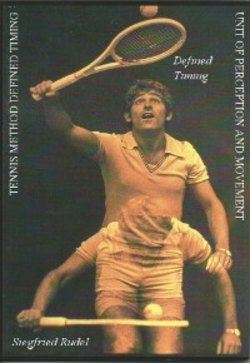Читать книгу Tennis Method - Defined Timing - Siegfried Rudel - Страница 14
2.1 Movement rhythms and definition zones
ОглавлениеThe definable perception zones and the corresponding movement structures are related to the four movement rhythms: groundstroke, half-volley, volley and smash.
Figure 9 shows the throwing and catching of the ball as a basic exercise from which the four movement rhythms are deduced
The curve in figure 10 shows the player's whole perception zone when performing the groundstroke. The broken part of the curve represents the hitting zone: racket face - ball (second falling).
Figure 10 : Definition zone - groundstroke
The movement structure 'sticking' of the racket face to the ball, which is a part of the hitting zone, can be seen in figure 11. This 'sticking' within the direct space of movement develops the 'drawing' of the ball curve in the distance.
Figure 11 : Movement rhythm groundstroke - 'sticking'
The curve in figure 12 is a demonstration of the whole perception zone for the half-volley. The broken part of the curve (rising section after the bouncing of the ball) is once again a representation of the hitting zone.
Figure 12 : Definition zone - half-volley
Figure 13 shows the corresponding movement structure with the example of the half-volley played out of the hand. Racket and ball are simultaneously at an identical height.
Figure 13: Movement rhythm half-volley - 'low'
Note: The requirement of a 'steady' perception has as its goal a slow guiding-beam-movement (eye-head-body-ball). The movement of the whole body when turning to the ball is a reasonable measure for achieving a retinal image which is as motionless as possible. Within the zone of a guiding-beam-velocity that is 'too high', a gap of perception is a reasonable equivalent. This particularly concerns the zone shortly after the bounce of the ball on the ground (high vertical angular velocity~of the guiding beam). Within the zone of the direct movement space of the body, the player avoids a too high horizontal angular velocity of the perception-guiding-beam by hitting the ball in front of the body (between himself and the intended direction of the ball).
Figure 14 shows the whole zone of perception when playing a volley.The broken part of the curve (first falling of the ball) represents the hitting zone.
Figure 14 : Definition zone - volley
Figure 15 shows the structure of the movement. The racket face follows the ball.
Figure 15 : Movement rhythm volley - 'drawing'
Figure 16 is an illustration of the perception and hitting zone for the smash, which is identical with the serve.
Figure 16 : Definition zone - serve/smash
Figure 17 shows how racket face and ball rise simultaneously as in the example of the serve. When the ball leaves the direct movement space of the body a guiding-beam movement of the horizontal axis of the racket keeps contact with the ball. The toss of the ball when performing the serve corresponds with the partner's lob when hitting a smash. Contrary to the rhythms of the groundstroke, the half-volley and volley, the target in this case is down on the ground i.e., the movement of the racket face is, as far as space is concerned, no longer performed downward - upward, but upward - down-ward.
Figure 17 : Movement rhythm serve - 'high'
